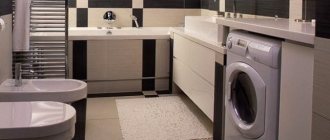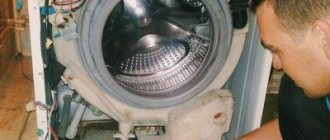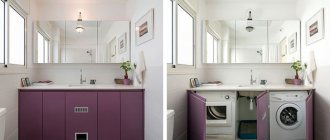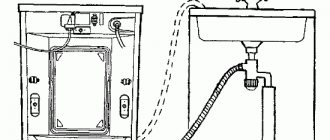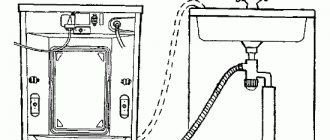The washing machine must be connected to three networks at once: water supply, sewerage and electricity. Therefore, it is necessary to choose a place for installation so that all three systems are located nearby or there is an opportunity to bring them there. The optimal places to install a washing machine are the bathtub, toilet and kitchen - they have all the necessary communications. Most often they require a little modification, but connecting the washing machine is not very difficult. The connection process itself is simple, you don’t need to do anything super complicated, if you have “direct” ones, you can do everything yourself.
Accommodation options
There are several places where you can put a washing machine:
- toilet;
- bathroom or combined bathroom;
- kitchen;
- corridor.
The most problematic option is the corridor. Usually there are no required communications in the corridor - no sewerage, no water. You will have to “pull” them to the installation site, which is not at all easy. But sometimes this is the only option. In the photo below there are several interesting solutions for how you can place the typewriter in the hallway.
The toilet has all communications, but in typical high-rise buildings the size of this room is such that it is sometimes difficult to turn around there - there is no space at all. In this case, washing machines are placed above the toilet. To do this, make a shelf so that when sitting on the toilet you do not touch it with your head. It is clear that it must be very durable and reliable, and the machine must have very good shock absorbers. In addition, they must be set perfectly, otherwise they may “jump away” during the spin cycle. In general, with this method of installing a washing machine, it doesn’t hurt to make several strips that will prevent it from falling off the shelf.
In the bathroom and combined toilet there is usually not very much space either, but still more than in the toilet. There is a choice here. If you have space, you can place the washing machine next to the sink. You can install a table top on top, which will be a logical conclusion and will also solve the problem of water getting on the body. To make everything look organic, you need to choose a machine of such a height that it fits into the size, and the sink itself is better square - then they will be wall to wall. If there is not enough space, you can slide at least part of the body under the sink.
There is a more compact way - to place the washing machine under the sink. Only the sink needs a special shape so that the siphon is installed at the back.
To place the washing machine under the sink you need a special sink
One of the sinks under which you can put a washing machine
The next option for installing a washing machine in the bathroom is on the side of the bath - between its side and the wall. Today, case sizes can be narrow, so this option is a reality.
Just keep in mind that installing such equipment in bathrooms or a combined bathroom is not the best idea. Due to increased humidity, the case begins to rust quickly (tested from my own experience). However, there is usually not a lot of space, although in principle, you can put the car under the washbasin or hang shelves above it. In general, it's up to you.
Another popular place to install a washing machine is in the kitchen. It is built into the kitchen set. Sometimes they close doors, sometimes they don’t. This is at the discretion of the owners. Several interesting photos are in the gallery.
Installation nuances
More often than not, the issue of installing a washing machine in the kitchen concerns not so much convenience as saving space. Despair forces us to look for exotic ways to solve this issue. But this is no reason to despair. If you put in some effort, you can use the washing machine as an interesting element of the interior. In general, the washing machine in the kitchen looks stylish. There are enough examples where it complements the design of the kitchen and harmoniously combines with other household appliances.
The washing machine in the kitchen can be built-in or free-standing. The first option is more expensive than the second and is chosen much less often. If the budget allows for built-in appliances, then, as a rule, the area of the apartment allows you to place the washing machine where it should be. A free-standing one is placed under the countertop, or separately from the kitchen furniture. Sometimes appliances are covered with facades to prevent kitchen grease from settling on the surface.
Before placing the machine in the kitchen, decide on the location and consider all possible little things that could interfere with the installation or normal operation of the device. When installing a washing machine in the kitchen, you need to pay attention to some features.
- Do not connect the machine directly to a regular drain under the sink. Then pipe leaks may not be immediately noticeable. Water will have time to seep into the neighbors below and ruin the flooring of the kitchen or other rooms. It is better to make a special outlet from the rear wall. Then the leak will be visible almost immediately.
- Some models of washing machines have a pocket for pouring powder that is slightly deeper than the main façade of the device. So the countertop can partially or completely block access to the basket. This problem is also relevant if you plan to cover the machine with a facade. As a rule, they tend to place the equipment deeper in order to attach hinges for doors. The further away the machine is, the less likely it is to add powder.
- When the machine is framed inside a furniture set, it is sometimes covered from below with a plinth. However, you need to remember that at the bottom in a special pocket there is a pipe for residual water drainage. If you need to use it, the base needs to be easy to dismantle.
- When choosing a place in the kitchen where to install the machine, remember not to place it near the stove. Firstly, it will quickly become dirty. Secondly, high temperatures contribute to breakdowns.
- Leave a small gap between the table top and the machine lid. If imbalance, vibration or rattling occurs, the device will not hit the table.
- Consider the depth of the furniture and car. Do not place equipment close to the wall; leave room for pipes. If facades are hung, the hinges should not scratch the body of the machine.
Removing the shipping bolts
Before connecting the washing machine, you need to unpack it and remove the mounting bolts and replace them with plugs.
The shipping bolts look something like this
This procedure is required immediately after unpacking. If you leave the bolts and turn on the machine, it will break. And this is not a warranty case. The number of bolts varies from manufacturer to manufacturer, but their installation diagram is in the instruction manual, and they are visible on the back wall. Just take a screwdriver and unscrew it, and close the opened hole with a plug.
Connection to water supply
First, let’s talk about what kind of water the washing machine is connected to. In general - to the cold. The water is then heated by heating elements as needed. Some owners, in order to save money, connect to hot water. This way, less energy is consumed when washing. But the savings are questionable - more hot water is wasted. If a meter is installed on the hot water supply, then it is cheaper to pay for electricity than for hot water. It is also worth considering that connecting a washing machine to hot water is not very good for laundry: the temperature causes the whites to curl and then not be washed well.
We were talking about ordinary washing machines, but there are models that connect to both hot and cold water. They have not one water inlet on the back wall, but two. In our country they are very rare - there is too little demand, and the prices for such equipment are much higher.
There are washing machines that connect to both hot and cold water
Now about the connection itself. The washing machine comes with a rubber hose, which is used to connect the washing machine to the water. Its length is 70-80 cm, which is not always enough. If necessary, you can buy a longer one in stores that sell plumbing fixtures (3 meters is not the limit, it seems).
This hose is screwed onto the corresponding outlet on the rear wall. There should be a sealing rubber gasket there, so there is no need to wind it up. Tighten the hose union nut (plastic) by hand; if you use wrenches, tighten it only half a turn. Not more.
Screw the inlet hose to a special outlet on the rear wall of the housing
The second end of the hose must be connected to the water supply system. If you have a free outlet somewhere that ends with a tap, great; if not, you need to make a tie-in.
How to avoid problems
A solution can always be found even in a small apartment. For example, take a thin layer of thermal insulation and place it between household appliances. In this situation, the gap can be reduced to 5 mm.
- Try to place old slabs at a distance of 2 to 5 cm from the washer.
- Do not keep the burners on for a long time to warm up the room, as this leads to rapid heating of the walls.
- Do not place devices too close so that vibration during operation of one of them does not damage the other.
- It is advisable to use adjacent equipment at the same time as little as possible. Wash clothes or cook consistently, even if it's inconvenient.
Where to route the drain hose
If there is a sink or sink siphon nearby, there is no problem. You don't even have to redo the sewer system. You will need to buy a special siphon with an outlet for connecting washing machines and other household appliances and install it in place of the old one.
One of the siphons for connecting the washing machine drain to the sewer system
Another option is to connect the washing machine to the sewer directly. To do this you can:
- change the sewer tee that goes to the sink;
- make a separate outlet.
Tee with outlet for connecting the drain of a washing machine
All these methods require alteration of the pipeline, but the connection will be major. There is one point: the diameter of the drain hose is much smaller than the size of the sewer pipes. To ensure tightness and ensure the absence of odors, special rubber cuffs are inserted into the outlets. The hose is simply stuck into them. The elastic edge of the cuff squeezes it, the connection is ready.
There are also temporary connection options. The drain hose is simply lowered into the bathtub, toilet or sink. This method, of course, is very simple, but not the best - the hose may fall, you may forget to put it back in place after turning on the machine, etc. Then the water drains directly onto the floor, and cleaning up the flood is not very pleasant, and even the neighbors below (if any) will definitely not be happy.
Lowering the hose into the toilet is simple, but unreliable
With any method of connecting the drain hose from the machine to the sewer, you must ensure that it does not bend or become looped. The corrugated drain hose is prone to blockages, so you need to ensure the minimum bend radius.
Rules for connecting a washing machine to the sewer
All this data is usually specified in the instructions, but usually the minimum bending radius is 50 cm, the maximum is 85 cm. In order to control the position of the hose, there are special plastic clamps that fit on top of the corrugation and hold it in the desired position.
Collar for fixing corrugations
Electrical connection
Since the power of the washing machine when the heating elements are turned on is decent, it is advisable to connect a separate power supply line to it from the panel. The circuit is simple - the phase from the input is supplied to the circuit breaker, from it goes to the RCD, then through a wire to the location where the socket is installed.
Connection diagram of the washing machine to the electrical network
All manufacturers emphasize that the outlet must be grounded. Only in this case the factory warranty remains valid.
Now about the denominations. The circuit breaker is selected according to the current required by the device. This figure can be found in your passport, or you can calculate it. It is necessary to divide the power of the washing machine by 220 V, we get the current consumption. For example, your unit has a power of 3.5 kW. We get 3500 W / 220 V = 15.9 A. We take the nearest larger rated circuit breaker. They come in 6 A, 10 A, 16 A, 20 A, 25 A. For our case, a 16 A machine is suitable.
Let's move on to choosing an RCD. In terms of current, it is taken one step higher than the rating of the machine, that is, for the example given it is 32 A. But the RCD has one more characteristic - leakage current. For devices that connect to a dedicated line, the recommended value is 10 mA. So, for a washing machine with a power of 3.5 kW, a 16 A automatic machine, a 32 A RCD, with a leakage current of 10 mA are required.
It would also be nice to calculate the cross-section of the wire. Today, cables with copper conductors are mainly used for wiring. They are more flexible and less heavy. The calculation is made based on power or current consumption, but since the power spread of washing machines is limited, we can immediately say that for devices up to 4.1 kW, a core cross-section of 1.5 square meters is sufficient. mm (copper conductors), up to 5.5 kW - cross-section 2.5 sq. mm.
And the last thing about electrics: about sockets. When choosing an outlet, keep track of more than just the presence of a grounding contact. You also need to look at what voltage the outlet is designed for. Normal products have markings on the back. The maximum operating voltage is indicated there. Sometimes the rated current is set. You know it too (or you can calculate it as described above). If there are no inscriptions, it is better not to risk it. Most likely this is cheap Chinese consumer goods and how it will work is a mystery.
Installing a socket
Sockets are rare in the dressing room, but even if there is one, it is better to install a new one. The fact is that a washing machine requires more power, therefore, the wires must be supplied with a sufficient cross-section . Otherwise, the conductor will overheat, ignite and cause a fire.
It is not recommended to use an extension cord to connect the machine - it is better to organize direct contact with the electrical network.
To convert an outlet or install a new one, you will need:
- socket with a moisture-resistant housing;
- new wiring with a core cross-section of at least 2 square meters. mm.;
- socket box;
- drill or wall chaser.
When all the tools and materials are prepared, we proceed to installation. First, we select a place for a new outlet, and then turn off the power supply to the apartment. Then we act like this.
- We make markings. We measure the height for the future outlet within 30-100 cm from the floor and mark the corresponding hole with a pencil.
- We calculate how many meters of wiring need to be laid from the washing machine to the junction box. It is recommended not to forget about a margin of 20-30 cm to facilitate installation and possible repairs. We mark the path to the shield with a pencil.
- We supply the drill with an attachment suitable for the type of wall and electrical fittings.
If you don’t have a suitable drill attachment, you can use a standard one: just drill a few holes in the wall, and then remove the remains with a chisel and hammer.
- We put on personal protective equipment: goggles, respirator and gloves.
- We connect the door to the electrical network. The use of an extension cord is allowed, as there is no need to limit the free use of the tool.
- Carefully drill a hole for the socket, following the markings.
- We make a 2-3 cm groove using a grinder or a chisel with a hammer.
- We clean all drilled holes from dust and remnants of building materials.
- We take out the socket box and fix it in the hole we made.
- We place the wire in the groove and insert one end into the shield and the other into the socket box.
- We cover the holes with wires with plaster or putty and wait for complete drying.
- We insert the socket and connect the wires.
- We head to the panel and connect the conductors to the corresponding contacts. It is strongly recommended to use terminals for connections, as twisting wires is dangerous and unreliable.
Once again we check the reliability of the fastenings and turn on the general electricity. Within a few minutes we try to detect a suspicious smell or the presence of smoke. Lastly, we insert any household appliance into the new outlet and evaluate the quality of the current supply. If everything is done correctly, then there will be no problems.
The last stage is setting the level
Connecting the washing machine to the water supply and sewerage system is not all. We need to provide her with normal working conditions. To prevent the washing machine from jumping during the spin cycle, it must be positioned strictly vertically. The position of the body is adjusted using adjustable legs. Take a building level, place it on the lid, change the height of the legs, ensuring that the bubble in the level is strictly in the center.
Check by placing the level parallel to the front part, then move it to the rear wall. Then the procedure is repeated, but the level is applied to the side walls of the case - on one side, then on the other. Once the bubble is strictly in the center in all positions, we can assume that the washing machine is level.
Checking the correct alignment of the washing machine
If there is no level, you can try to level the machine by placing a glass with a rim filled with water on it. The water level is up to the rim. Change the position until the water is exactly along the rim. This method is less accurate, but better than nothing.
There is one more point. Most often, washing machines are placed on a tiled floor, which is slippery and hard. That’s why even a perfectly aligned machine sometimes “jumps”—it’s impossible to dampen the vibration when spinning on a hard floor. To cope with the situation, you can place a rubber mat under the machine. It serves as an excellent shock absorber.
Without such a household assistant, rarely is any housewife able to cope with household chores. The usual places for SMA are considered to be the bathroom or kitchen, but it happens that the dimensions of the listed rooms do not allow installing even the narrowest models in them. The hallway turns out to be an unexpected and quite convenient option, although its space is limited for numerous maneuvers. However, let's try to figure out how to hide a washing machine in the hallway.
Dimensions of the machine
To make selection easier, manufacturers usually produce standard models. As a rule, the depth of such units is 55 centimeters, width - 60, and height - 83-85 cm. Such products are slightly lower than free-standing devices, since they need space for embedding and mounting a countertop.
To facilitate the process of installing the front panel, small recesses are provided in this technique even at the design stage. They are located at the bottom of the front part.
What should you pay special attention to?
It happens that the hallway turns out to be the last place where it is possible to install washing equipment. If you do not take advantage of this opportunity, you will have to abandon this unit altogether and take things to the dry cleaner or wash them by hand. The first option is quite expensive, the second is complicated, so it’s better to place the machine in the hallway.
This is technically possible, but some nuances will have to be taken into account:
- the size of the entire corridor, the availability of free space is clarified, whether the washing machine will interfere with opening the front door or passage to one of the rooms;
- at what distance will the washing equipment be located from the source of water supply and sewer drain;
- is there a niche in the hallway where you can disguise the washing machine by putting it in a closet;
- device dimensions. This is important if the corridor area is small - you will have to make a choice in favor of a narrow machine model;
- Remember the aesthetics of the issue - a washing machine in the hallway is not considered a common option. Anyone who enters the hallway will feel like they are in a small laundry room, so it is best to hide such equipment safely in a closet.
How to disguise a washing machine in the hallway
It is important not only to install this household appliance in the hallway, but also to successfully hide it from prying eyes. To do this, it is proposed to use one of the options:
- If there is a niche in your hallway, you can install a washing machine in it. When creating a separate niche for a machine, it is recommended to draw up a floor plan taking into account the size of the washing machine, model and everything that is supposed to be placed nearby - shelves for washing powders, a drying device;
- install the machine in a cabinet - wall-mounted, floor-mounted or built-in. Cabinets are made in the form of cabinets or narrow pencil cases, for which various materials are used. You can make a whole closet in the form of a compartment, providing a system of shelves inside for everything you need for washing clothes;
- if the size of the hallway is limited, install a washing machine and hide it behind a regular curtain. The curtain must be chosen to match the overall style of the hallway.
Selecting a location
When choosing the location of a household appliance, it is wise to give preference to a place in close proximity to the kitchen sink . This will simplify connecting the machine to communications for draining and collecting water.
If this is not possible, you should not only take additional care of the connecting hoses for extension, but also think about how to hide them. It is better to install the machine away from the oven, otherwise it is important to ensure good thermal insulation.
The best option is to mount the machine under a common countertop or place it behind a separate door. This allows not only to perfectly fit the unit into the interior, but also to reduce the noise level.
Advice. If there are small children at home, equip the closet with a special lock to prevent them from getting to the machine and washing powder.
The top-loading unit can be conveniently placed in the corner of the room.
Rules for connecting an SMA installed in the hallway
There are certain features here, mainly involving the question of how to hide the hoses through which the washing machine pumps in clean water and drains waste water. If the machine is located in a closet near the wall bordering the bathroom, then the process of connecting and masking communication lines is simple - just make a hole of a suitable diameter in the wall.
In order to connect the washing machine, you will have to purchase filler and drain hoses of the appropriate length. It is not recommended to join short pieces to avoid possible leaks. Note that the length of the hose has a direct impact on the operation of the drain pump, but this also depends on the brand of your laundry machine. As a rule, for most washing machines the recommended hose length should not exceed three meters, but this condition does not apply to devices from Zanussi - the machines are equipped with powerful drain pumps.
The drain hose of a washing machine installed in the hallway can be connected to a siphon or directly discharged into a sewer pipe. The methods are known, there is nothing complicated in their implementation. But you can connect the water intake hose in three ways, each of which we will consider in more detail:
- You can use a release coupling if the water supply is made of steel pipes. The coupling is placed on the pipe and a hole is made for water flow. A tap is connected to the coupling, which has a threaded outlet for the water intake hose of the washing machine;
- if water is supplied through metal-plastic pipes, the connection is made using fittings. An insert is made in the pipe, a fitting is connected, the joints are carefully sealed, and a rubber gasket is inserted. A tap with an inlet hose leading to the machine is screwed to the fitting;
- Using a tee, you can connect the washing machine hose to the sink faucet in the bathroom. A tee equipped with a tap is connected between the mixing hose and the water pipe; the water intake hose of the washing machine is connected to the branch.
Connection and installation
Let us dwell in more detail on the various machine models and the features of their installation.
Model selection
When choosing a model, take into account its dimensions and type of loading . If the device will be installed under a countertop, you should make sure that the height of the machine allows it to fit freely into the kitchen set.
Important! When installing under a countertop, make sure that it does not block access to the detergent compartment. With this placement option, it is convenient to use models in which the powder compartment is located on the machine door.
If the chosen model does not fit in height, do not rush to abandon it . For most appliances, you can remove the top panel and thereby reduce the height of the machine.
Front and vertical loading
There are also vertical and front loading washing machines . For top-loading appliances, the hatch for storing laundry is located at the top. These models are not suitable for installation under a countertop.
If the kitchen set has a common countertop , choose front-loading models with a door for storing laundry located on the front panel.
If necessary, it can be built into kitchen furniture and a machine with vertical loading of laundry , but in this case you will have to make a folding tabletop. This option is more difficult to implement, but it saves space, since devices with vertical access are narrower than front-facing machines.
The height of most washing devices does not exceed 85 cm , so the countertop is placed at a height of at least 90 cm from the floor. A distance of 5-6 cm is left to the right and left of the machine - this is how the unit vibrates during operation.
Important! Installing the unit directly on ceramic tiles or porcelain tiles reduces vibration noise.
Next to household appliances, it is convenient to equip a separate cabinet for storing household chemicals . And be sure to equip it with locks if there are small children in the house.
Some tips for making a cabinet
If you are planning to hide SMA in a closet (or cabinet), you can use various building materials to make them:
- using MDF panels you can easily make a cabinet that will easily fit into any interior with its shapes and colors;
- a good solution is natural wood material. Such furniture will fill the hallway with comfort, but before installing washing equipment, its internal parts will have to be additionally treated with a water-repellent composition;
- steel and glass in combination will add modernity and technology to the corridor. To make the door leaf, transparent or frosted tempered glass is used;
- panels for making furniture are a durable and beautiful natural material, furniture from which has a long service life. To make such shields, wood is used, previously cut into strips, which are then glued together.
The cabinet can be made in a floor-standing or built-in form; a wall-mounted design would also be a good solution. Furniture shapes for installing a washing machine can be straight or angular.
Features of the placement of the washing machine
Having decided that a washing machine in the hallway is the only possible option, you should take into account the features of its placement:
- The area of the room and its shape. If the size of the hallway allows, you can arrange a laundry room in the closet, where you can place an additional drying machine, laundry basket, and cleaning products. For more modest possibilities, use a corner or niche to build a closet there.
- Location of water supply and sewerage. The more distant the communications, the greater the likelihood of washing equipment failure due to the load on the pump.
- Possibility to hide the car. The best option would be to create a special niche and disguise it with a door.
Recommendations for choosing a location
Ideally, the washing machine in the kitchen should be placed where it will look harmonious and where there will be no problems with ease of use. Everything else is not so important, since modern technologies make it possible to create models that will function perfectly even in a suspended state.
Before you decide to place a washing machine in your kitchen, you need to carefully examine the room and really evaluate it. In some cases, installing such equipment in this area is generally impractical. To save precious square meters, the device can be installed in a special niche or corner.
It is also preferable to place it closer to engineering and technical communications. Lengthening the hoses coming from the machine can lead to a significant increase in the load on the pump. As a result, it will simply fail. To avoid such situations, it is recommended to install the equipment close to the sink. This proximity allows you to create a so-called wet zone and concentrate all measures aimed at protecting against moisture in one place.
Washing machine connection options
The washing machine should be installed closer to sewer drains and water pipes. Therefore, the ideal option is to place it against the wall of the bathroom, supplying water directly through it. If the distance to communications is large, use long hoses, avoiding connections. Otherwise, leaks will be inevitable.
You can organize the water supply in one of the following ways:
- If the pipe is metal, the connection is made using a release coupling, which is attached to a pipe with a drilled hole. A 3/4 ball valve for the hose is screwed onto it.
- The connection to a metal-plastic pipe can be made using a fitting. The cutting area should be sealed with a rubber band, then a tap should be placed on the fitting, and a hose on it.
A tee between the mixer and the water supply is another option for connecting the machine.
Tee in the bathroom between the machine mixer. The position of the electrical outlet is also a point that should be taken into account: it is better if it is placed next to the machine. If it is not there, you should consider installing it. The use of an extension cord is not advisable due to the dangerous proximity of water.
Design Features
Before installing the equipment, you need to inspect the selected room and determine the most advantageous place for washing. Owners should consider the following points in such cases:
- You shouldn’t immediately gouge the walls to identify a new outlet. Initially, it is worth assessing the chosen location for compliance with the protruding elements, height and width.
- In addition to the main size of the device, it is worth retreating about 10 cm, since hoses will be located on the back side of it.
- When a place has been allocated, you will need to check the strength of the floor. If the apartment is old and the flooring leaves much to be desired, it is better to fill the allocated space with concrete or lay tiles on it. Wooden pop can cause the body to collapse. The floor structure must support up to 90 kg of weight.
- If the floor in the apartment is uneven, then there is no need to worry. You can adjust the stability of the equipment using a building level.
- It is also worth choosing a place that is located near a sewer pipe. If it is located at a distance of more than 3 meters from the washing machine, dirty water will be difficult to drain, which will lead to subsequent breakdowns.
- Before installation, you need to inspect the hose from the washing machine. Usually it has a length of up to 1.5 m. If this size is not enough, it is worth changing the hose to a longer one.
Once all the parts are prepared, you can begin the installation process.
Ways to disguise this technique
Installing a washing machine in the hallway requires extra effort to disguise it, because you don’t want to bring guests through the laundry room.
- Niche. If there is one in the hallway, you can make a closet in it. When organizing a separate niche for a washing machine, you should develop a layout taking into account the size, model and what will be located on the shelves next to it: a dryer, laundry detergents.
Cabinet for washing machine
The washing machine cabinet can be made of various materials:
- MDF panels. Due to the fact that the cabinet can have a different shape and color, it can easily fit into the interior of any style.
The cabinet for the washing machine can be built-in or floor-mounted. The hinged design is an excellent option for a compact model. The shape of the cabinet can be angular or straight.
Cabinet doors are installed taking into account the capabilities of the room and the type of loading of the machine. They can be hinged, sliding or folding. Vertical blinds can also serve as shutters.
A washing machine placed in a closet in the hallway is an unusual, often forced solution. But if you think through all the details of its installation, it will serve you faithfully and at the same time not spoil the appearance of the apartment.
